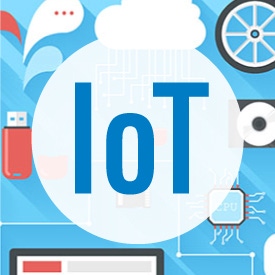
Verizon's strategy for the emerging IoT market ranges all over the proverbial map, and nowhere is that more evident than in the company's latest report on the state of the IoT sector.
In this year's version of its annual IoT roundup, Verizon Communications Inc. (NYSE: VZ) lumps together a wide variety of technologies and services under the single defining concept of the Internet of Things. Which, to be fair, is a pretty broad term by itself. It's the "Internet," which now defines virtually any type of communications network, and "Things," which conveniently could mean almost anything.
In Verizon's case, however, IoT encompasses all of the expertise it's gathered through corporate acquisitions (in smart lighting, digital kiosks, etc.), plus the software platform ThingSpace, plus Verizon's new Cat M1 network. Sometimes those components work together, but just as often they're completely independent of one another. To draw a thread through these assets, Verizon reports on the massive business-to-business opportunity they represent, noting that Gartner Inc. forecasts total spending on both connected things and services to reach $2 trillion in 2017. At the same time, the telco tells a very different story about how it approaches that value, depending on where the company has so far made progress in any given sector.
For example, to talk about asset management, Verizon references a deal it announced with the city of Columbus, Ohio to manage YellowCab reservations using a Verizon Share software solution. The Verizon software lets taxi drivers consult a mobile app to determine where the nearest available YellowCab car is located, and then use the app to scan the vehicle and rent it out for a shift of driving customers around town. According to Verizon IoT Vice President Mark Bartolomeo, the Verizon Share software connects to the company's ThingSpace platform, which determines how assets are provisioned and managed. However, there's no major network play for Verizon in the deal. It's a software sale.
In contrast, when Verizon talks about IoT in the context of the city of Sacramento, Calif., it highlights the free WiFi it will provide in public parks. That free WiFi is an offshoot of the fiber Verizon will also deploy, which in turn will help backhaul future high-margin wireless services. (See Verizon Takes 'One Fiber' to More Cities.)
Although Verizon is also connecting 15 digital kiosks around the city, and outfitting traffic lights with intelligent management capabilities at a dozen or so different intersections, the main component here is Verizon's network expansion, an entirely different focus from the Columbus case study.
At one end of the IoT spectrum, Verizon is building on its existing network strength and continuing to expand. On the other end, the telco is vacuuming up capabilities that allow it to pursue everything from drones to fleet management to smart LED lighting applications.
More than a patchwork quilt
For all of Verizon's seemingly haphazard approach to IoT, however, it's not fair to discount the company's strategy in the market as just a combination of the same-old network story plus a sprinkling of unrelated applications. There are two big bets the company is making: its ThingSpace platform, and a new business model for selling services via Verizon's recently deployed Cat M1, low-power wide-area IoT network.
ThingSpace, just like Cisco Systems Inc. (Nasdaq: CSCO)'s Jasper, Apple Inc. (Nasdaq: AAPL)'s HomeKit and others, offers a web-based platform for managing IoT deployments. No one platform has gained overwhelming market traction yet, but the race is on to build the best ecosystem of manufacturer and software development partners. The one who has the best ecosystem gains the most influence over how future IoT business unfolds. (See Verizon Makes Major IoT Push.)
Verizon isn't sharing much information yet on the scale of existing ThingSpace deployments, but Bartolomeo does note that the company has roughly 14,000 developers registered on the platform.
Want to know more about the Internet of Things? Check out our dedicated IoT content channel here on Light Reading.
The Cat M1 network is even more interesting. Verizon announced the nationwide launch of its Cat M1 IoT infrastructure in March, but the company's big innovation may be less the network itself than the pricing framework it's created to sell connectivity. (See Verizon Takes IoT Network Nationwide.)
"We've been working on this for some time now, and we have launched the rate plans," says Bartolomeo. "Those rate plans are actually out in the market place that show you the various types of pricing options that are available for IoT." They include consumption-based plans, annual-fee plans and plans for five-year and even ten-year connectivity.
"There will be some models where the manufacturer is just going to incorporate that cost into the cost of the equipment that they're providing," says Bartolomeo. "And in the scheme of things, that will be a fairly marginal cost. There will be other use cases where the capability is delivered to the consumer and the consumer would have an option of activating it, and they could activate that on something like their Verizon Share plan to be able to use that data that they're currently consuming with their network service provider today. Or there are other plans based on specific use cases where they could buy a data consumption package."
Verizon is highly focused on setting IoT pricing models based on use cases. That's very different from the company's consumer wireless business.
The IoT market is wide open
In Verizon's just-released IoT report, the emphasis is on the broad range of technologies and solutions the telco is pursuing in the market. However, there are foundational components in the company's strategy that give Verizon more grounding than it first appears -- a platform, a network and new pricing flexibility.
Whether the rest is just window dressing remains to be seen. But, as the market is still emerging, Verizon still has time to figure that out.
— Mari Silbey, Senior Editor, Cable/Video, Light Reading
About the Author(s)
You May Also Like











